
The Archdiocese of Detroit is a Latin Church ecclesiastical territory or archdiocese of the Catholic Church covering the Michigan counties of Lapeer, Macomb, Monroe, Oakland, St. Clair, and Wayne. It is the metropolitan archdiocese of the Ecclesiastical Province of Detroit, which includes all dioceses in the state of Michigan. In addition, in 2000 the archdiocese accepted pastoral responsibility for the Catholic Church in the Cayman Islands, which consists of Saint Ignatius Parish on Grand Cayman.
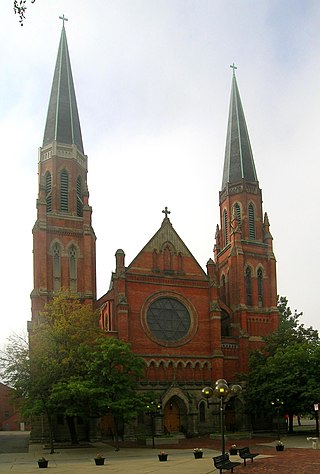
Basilica of Sainte Anne de Détroit (Sainte-Anne-de-Détroit) was founded July 26, 1701 by French colonists in New France, and is the second-oldest continuously operating Roman Catholic parish in the United States. The current Gothic Revival cathedral-styled church, built in 1886, is located at 1000 St. Anne Street in Detroit, Michigan, in the Hubbard-Richard neighborhood, near the Ambassador Bridge, and the Michigan Central Station. At one time it was the seat of a diocese that included French territory in Ontario, Canada south of the Detroit River.

St. Florian Church is a Roman Catholic Church at 2626 Poland Street in Hamtramck, Michigan. The church was designed by Ralph Adams Cram of the firm Cram and Ferguson.

St. Mary Star of the Sea Catholic Church is a parish of the Roman Catholic Church located in downtown Jackson, Michigan, in the Diocese of Lansing. It is dedicated to Our Lady, Star of the Sea. In 2008 it absorbed the congregations of St. Stanislaus Kostka Chapel and the Chapel of Sacred Heart, also in Jackson.

Holy Redeemer High School was a Roman Catholic secondary school located in Southwest Detroit, at the corner of Junction and Vernor streets, near the Ambassador Bridge to Canada. It was overseen by the Archdiocese of Detroit.
Stephen Stanislaus Woznicki was an American prelate of the Roman Catholic Church. He served as bishop of the Diocese of Saginaw in Michigan from 1950 to 1968. He previously served as an auxiliary bishop of the Archdiocese of Detroit in Michigan from 1937 to 1950.

Our Lady of Mount Carmel Church is located at 976 Pope John Paul II Ave. in the Detroit suburb of Wyandotte, Michigan. The church serves the Roman Catholic Polish Personal Parish of Our Lady of the Scapular as a result of a parish merger on August 1, 2013 of the Wyandotte Polish Personal Parishes of Our Lady of Mount Carmel (1899–2013) and St. Stanislaus Kostka (1914–2013).
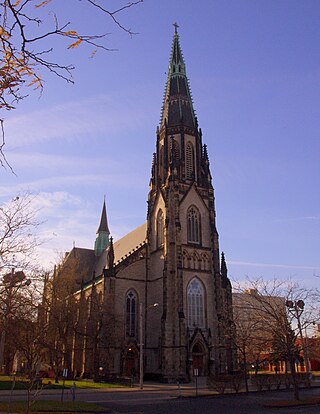
St. Joseph Shrine, founded in 1855, is a historic German Catholic church located at 1828 Jay Street in the Eastern Market–Lafayette Park neighborhood area just outside downtown Detroit, Michigan, on the city's central east side. The building was listed on the National Register of Historic Places in 1972, and deemed "of national importance" because of its stained glass. Three subsidiary buildings—the rectory, convent, and the Wermers House—were added to the listing in 1992. It is under the jurisdiction of the Archdiocese of Detroit, and presently a shrine dedicated to the celebration of the pre-Vatican II liturgy under the care of the canons of the Institute of Christ the King Sovereign Priest.

The Sacred Heart Roman Catholic Church, Convent and Rectory is a Roman Catholic church complex located at 1000 Eliot Street in Detroit, Michigan. It was designated a Michigan State Historic Site in 1975 and listed on the National Register of Historic Places in 1980.

The Chapel of St. Theresa–the Little Flower was a church located at 58 Parsons Street in Midtown Detroit, Michigan. It was later known as St. Patrick Church. The building was listed on the National Register of Historic Places in 1997, and demolished in September 2023.

Sts. Peter and Paul Academy is a Catholic school building located at 64 Parsons Street in Midtown Detroit, Michigan. It currently serves as the St. Patrick Senior Center. It was listed on the National Register of Historic Places in 1997.
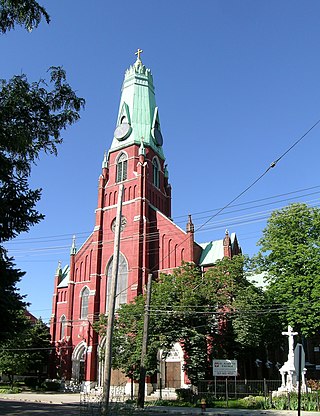
St. Albertus Roman Catholic Church is in the Forest Park neighborhood of Detroit, Michigan. It was designated a Michigan State Historic Site in 1974 and listed on the National Register of Historic Places in 1978.
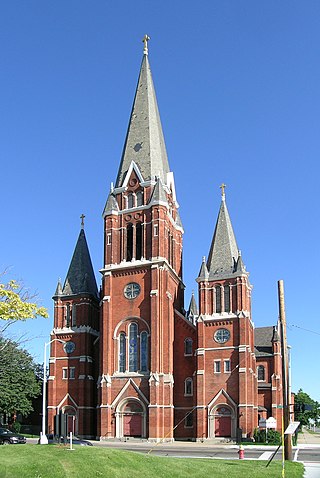
St. Josaphat Roman Catholic Church is a Roman Catholic church located at 715 East Canfield Street in Detroit, Michigan. It was listed on the National Register of Historic Places in 1982 and designated a Michigan State Historic Site in 1985. Since 2013, it has been one of two churches that comprise Mother of Divine Mercy Parish.

The St. Stanislaus Bishop and Martyr Roman Catholic Church is a church located at 5818 Dubois Street in Detroit, Michigan. The church was listed on the National Register of Historic Places in 1989.

The Assumption of the Blessed Virgin Mary Church is a Catholic church of the Archdiocese of Detroit located at 13770 Gratiot Avenue in Detroit, Michigan. It is commonly known as the Assumption Grotto Church. The church community was founded in the 1830s, and the present building completed in 1929, designated a Michigan State Historic Site in 1990 and listed on the National Register of Historic Places in 1991.

The Most Holy Redeemer Church is located at 1721 Junction Street in Southwest Detroit, Michigan, within the West Vernor–Junction Historic District. The church was once estimated as the largest Roman Catholic parish in North America. West Vernor–Junction Historic District is adjacent to Mexicantown and contains a growing Mexican community and resurgent neighborhood.

St. Mary Roman Catholic Church, formally the Church of the Immaculate Conception of the Blessed Virgin Mary, is in the third oldest Roman Catholic parish in Detroit, Michigan. Designed by German-born Peter Dederichs and built for the formerly ethnic German parish of the 19th century, it is located at 646 Monroe Street in what is now considered the heart of the Greektown Historic District in downtown Detroit. It is often called "Old St. Mary's Church" to avoid confusion with other St. Mary's parishes: in the Redford neighborhood of Detroit, or in nearby Royal Oak, Monroe, or Wayne.
Joseph Casimir Plagens was a Polish-born prelate of the Roman Catholic Church. He served as bishop of the Diocese of Grand Rapids in Michigan from 1941 to 1943.

The Saint Paul Catholic Church Complex is located at 157 Lake Shore Road in the Detroit suburb of Grosse Pointe Farms, Michigan. The group includes a French Gothic-style church, a Neo-Tudor rectory, a Colonial Revival parish hall, a Neo-Tudor school building, and an Elizabethan Revival convent. The complex was designated a Michigan State Historic Site in 1992 and listed on the National Register of Historic Places in 1994.
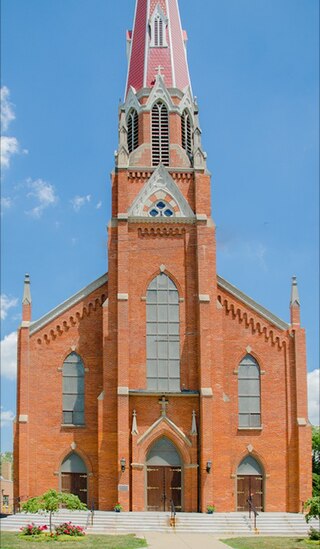
Saint Michael the Archangel Church is located on the west side of the city of Monroe, Michigan, along the River Raisin and is a part of the Archdiocese of Detroit. Its congregants include over 1,000 registered families. It was founded in 1852. Its current pastor is Rev. Kishore Battu, who has been serving the St. Michael community since August 1, 2020.




























